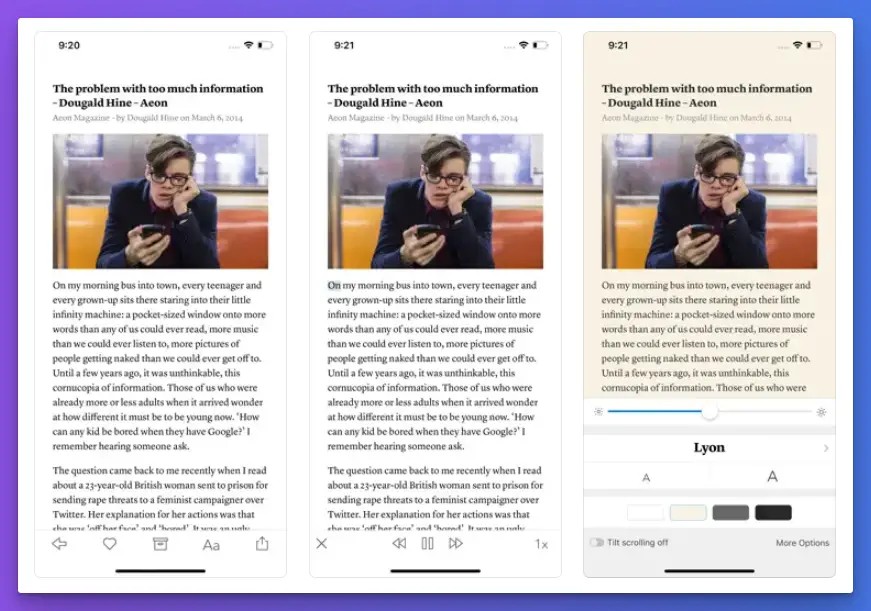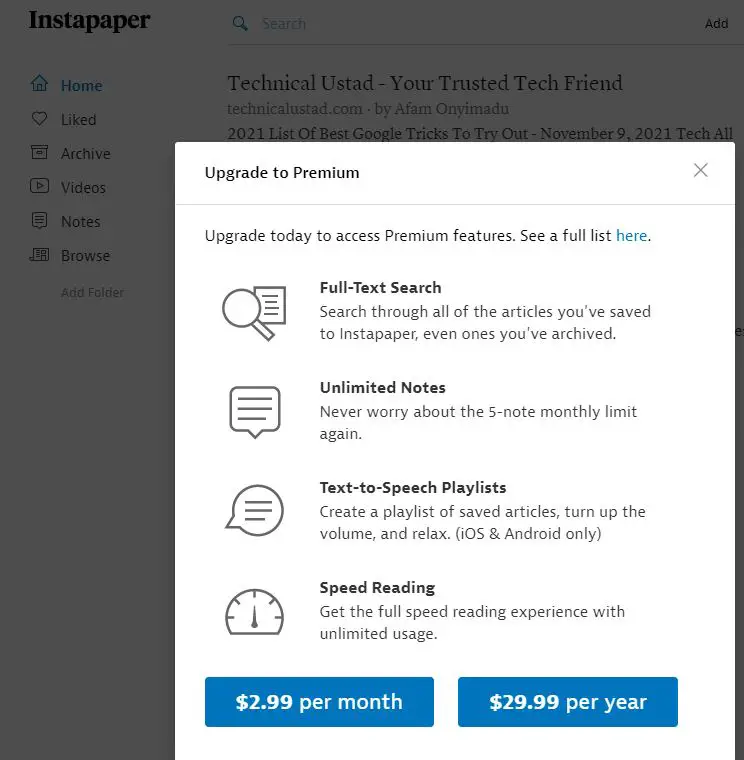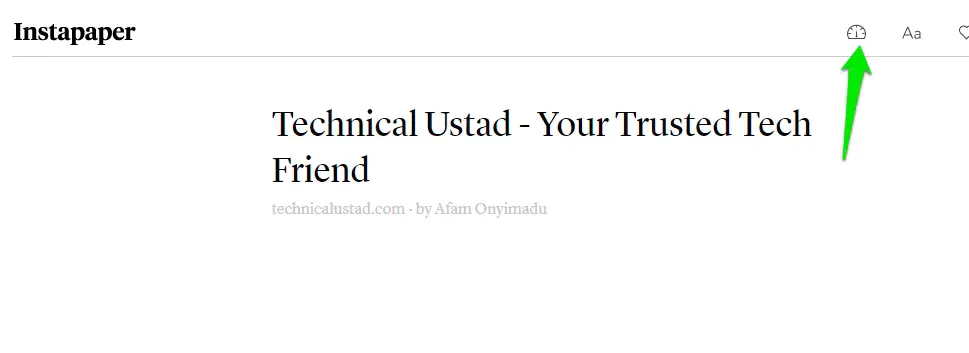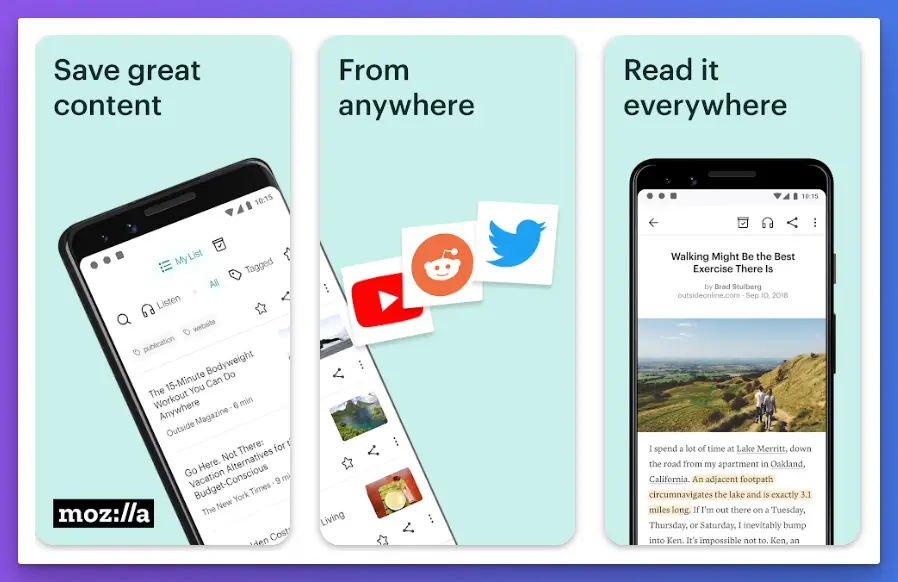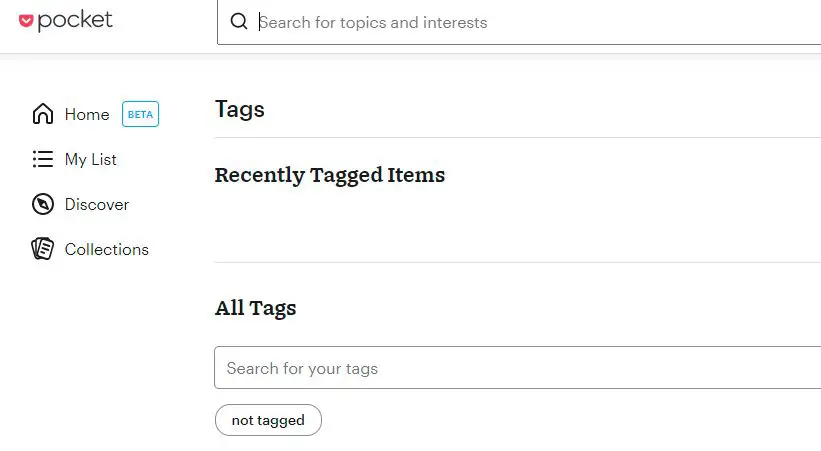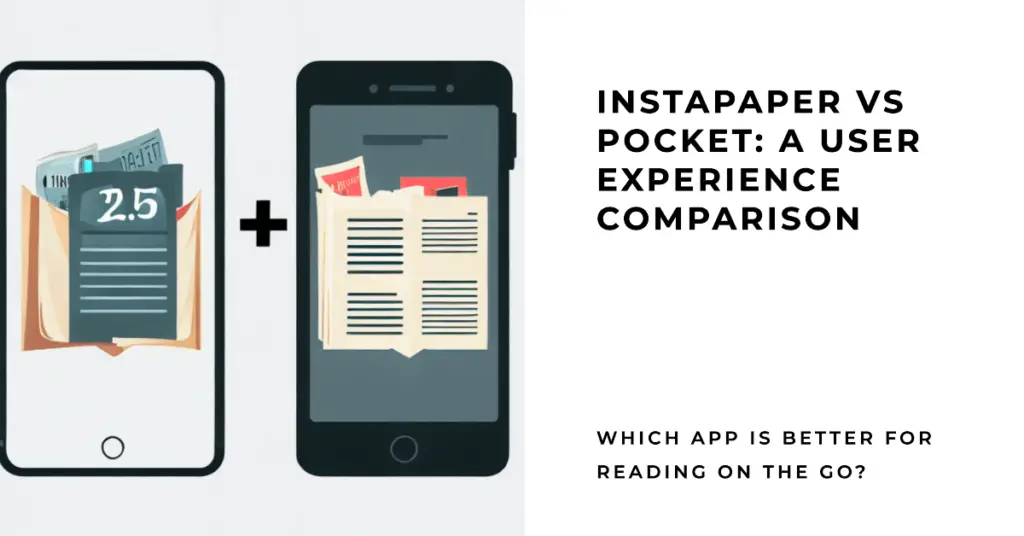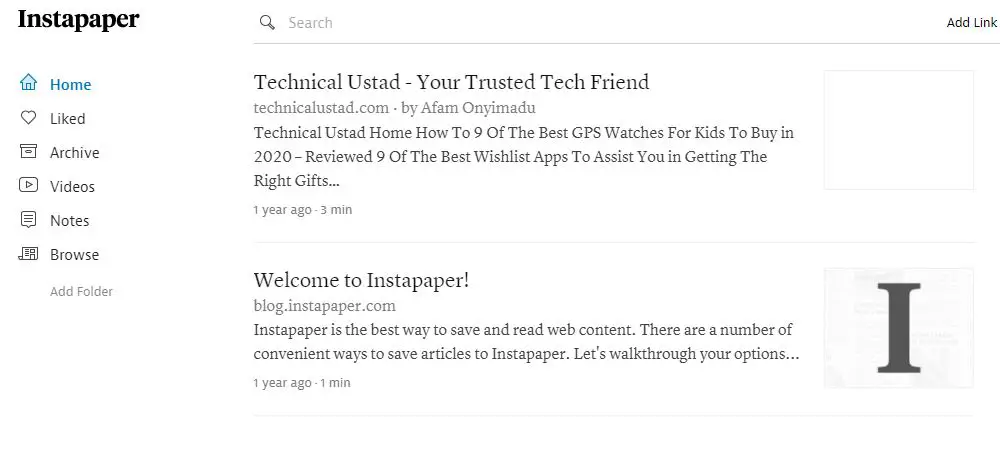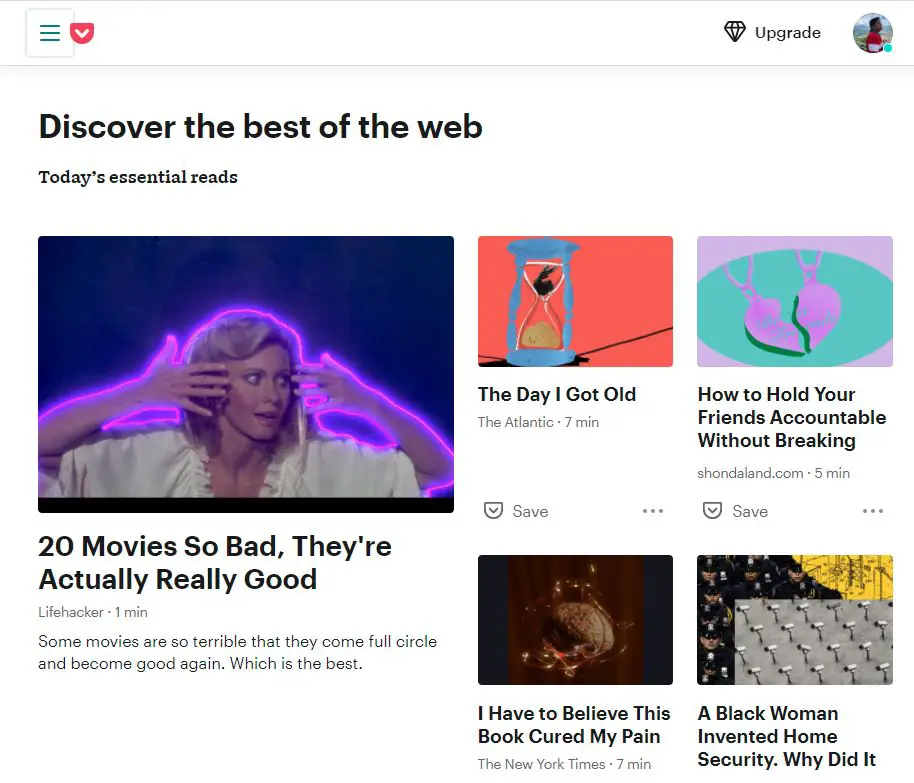The growing influx of digital content often overwhelms us in today’s fast-paced world. We’re constantly encountering intriguing articles, blogs, and think pieces across multiple platforms, but finding the time to read them all is challenging.
How do you ensure you don’t lose that intriguing article you stumbled upon during your morning commute? That’s where read-it-later apps like Instapaper and Pocket come in.
Still, choosing the right read-it-later app isn’t always straightforward. You might ask: Which has the better user interface?
Which is more reliable in storing articles for offline reading? Which provides a better reading experience? And most importantly, which one will better fit into your day-to-day life? If you’re finding it hard to decide, you’re not alone.
This article demystifies the “Instapaper vs Pocket” debate. We’ll dive deep into both platforms’ features, pros and cons, user experiences, and unique offerings.
By the end, you’ll clearly understand which read-it-later app best suits your needs, helping you manage your reading list effectively. So, let’s begin this journey and find the best solution for your digital reading needs.
Background Information
Instapaper and Pocket, two prominent platforms in the realm of online reading, have played a pivotal role in revolutionizing how we consume and engage with digital content.
Instapaper, founded in 2008 by Marco Arment, quickly gained traction among users seeking a seamless way to save and read articles later.
Its minimalist design and focus on readability set it apart from the cluttered webpages prevalent at the time. Instapaper’s unique feature, “Read Later,” empowered users to curate a personalized reading list, making it a go-to tool for avid readers.
Similarly, Pocket (formerly Read It Later) emerged in 2007, spearheaded by Nate Weiner. This platform, with its refined interface and robust offline accessibility, aimed to address the challenges of information overload. Users could save articles, videos, and webpages effortlessly, thus curating their digital library.
The impact of these platforms on online reading habits has been profound. They fostered a paradigm shift in how people consume content by emphasizing convenience, distraction-free reading, and personalized curation. Instapaper and Pocket encouraged deliberate engagement with online content by allowing users to save articles for later, breaking the cycle of incessant browsing.
Furthermore, these platforms facilitated knowledge acquisition, enabling users to access their saved articles offline. This aspect was especially valuable for individuals with limited internet connectivity or those who preferred uninterrupted reading experiences.
Instapaper and Pocket transformed how we read and disrupted the traditional publishing landscape. Publishers began optimizing their content for readability and mobile-friendly formats, recognizing these platforms’ prevalence and potential to reach wider audiences.
In conclusion, the short history of Instapaper and Pocket reveals their enduring impact on online reading habits. They revolutionized how we engage with digital information by providing tools for saving, curating, and consuming content.
These platforms continue to shape our reading experiences, empowering users to navigate the vast digital landscape easily and intentionally.
The Features of Instapaper
Instapaper, a renowned platform for digital content consumption, boasts a wide range of features that elevate the reading experience and empower users to curate their digital libraries.
Distraction-Free Reading:- At the heart of Instapaper lies its commitment to providing users with a seamless readability experience. Instapaper’s clean and minimalist interface removes unnecessary clutter and distractions, allowing readers to immerse themselves fully in their content.
Offline Accessibility:- One of the standout features of Instapaper is its ability to save articles for offline reading. This feature proves invaluable for users on the go or in areas with limited internet connectivity. By synchronizing saved articles to their devices, Instapaper ensures that users can access their reading material anytime, anywhere, even without an internet connection.
Text-to-Speech:- Instapaper recognizes the growing demand for multimodal consumption and offers a remarkable text-to-speech feature.
This feature allows users to convert written content into audio, enabling them to listen to articles instead of reading them. It caters to individuals with visual impairments or those who prefer auditory learning, expanding accessibility and inclusivity.
Highlights and Annotations: Instapaper empowers users to actively engage with their saved content through its highlighting and annotation capabilities. Users can mark important passages, quotes, or ideas within articles, making it easier to revisit and extract valuable insights later. This feature promotes critical thinking and knowledge retention.
Organization and Tags: Instapaper allows users to organize articles using folders and assign tags to facilitate efficient content management. Users can easily create folders based on topics or themes, allowing them to categorize and navigate their saved content. Tags offer further granularity, enabling users to classify articles by specific keywords or topics and enhancing discoverability.
Speed Reading: Instapaper recognizes the value of time and offers a unique speed reading feature. By presenting text one word at a time in rapid succession, this feature aims to improve reading speed and comprehension. It’s a useful tool for individuals looking to absorb information quickly and efficiently.
Article Search: Finding specific articles within a vast collection can be daunting. Instapaper simplifies this process with its article search functionality. Users can effortlessly search for keywords, titles, or tags, swiftly locating the desired articles and saving valuable time.
Social Sharing: Instapaper understands the importance of collaboration and knowledge sharing. With its built-in social sharing capabilities, users can easily share interesting or valuable articles through various platforms such as Twitter, Facebook, or email. This feature fosters engagement, encourages discussions, and expands the reach of valuable content.
In conclusion, Instapaper offers comprehensive features to enhance the reading experience and promote personalized content curation. From its distraction-free reading environment and offline accessibility to the text-to-speech capability and annotation tools, Instapaper caters to a wide range of user preferences and needs.
The platform’s emphasis on organization, searchability, and social sharing further solidifies its position as a leading tool for individuals seeking a seamless and customizable digital reading experience.
Overview of Instapaper Pricing: Free Version and Premium Version
Instapaper provides users with a free and a premium version, each offering distinct features and benefits to enhance the reading experience.
Let’s delve into what each version offers:
1. Free Version:-
The free version of Instapaper grants users access to a range of essential features, allowing them to save and consume digital content easily. Here’s what you can expect from the free version:
Unlimited Saving: Users can save unlimited articles, webpages, and videos to their Instapaper account.
Readability Enhancements: Instapaper’s clutter-free interface and clean formatting ensure a distraction-free reading experience.
Offline Saving: Users can save articles for offline reading, enabling them to access their saved content without an internet connection.
Text-to-Speech: The free version includes the text-to-speech feature, enabling users to listen to audio-edited articles.
Highlighting: Users can highlight important passages and quotes in articles to facilitate future reference and retention of knowledge.
Folder Organization: The free version allows users to organize their saved content into folders based on topics or themes.
2. Premium Version:-
For users seeking an enhanced reading experience and additional features, Instapaper offers a premium version with a subscription-based pricing model. The premium version builds upon the free version and offers the following exclusive features:
Full-Text Search: The premium version includes powerful search functionality that allows users to search for keywords, titles, or tags within their saved articles, making it easier to locate specific content quickly.
Unlimited Highlights: Premium users can use unlimited highlighting to mark and save important passages without limitations.
Speed Reading: The premium version introduces a speed reading feature that rapidly displays text one word at a time, improving reading speed and comprehension.
Text-to-Speech Playlists: Premium users can create playlists of articles to be read aloud in the text-to-speech mode, providing a customized listening experience.
Send to Kindle: Subscribers can seamlessly send articles from Instapaper to their Kindle devices for a convenient reading experience.
Permalink Archive: The premium version offers a permanent archive of all saved articles, ensuring users can access their content even if the source becomes unavailable.
The premium version of Instapaper is available through a subscription plan, allowing users to unlock additional features and enjoy an enhanced reading experience.
In summary, Instapaper provides a free version with essential features for saving and consuming digital content, while the premium version offers a more comprehensive set of tools and benefits.
Users can choose the option that best aligns with their reading preferences and needs, whether it’s the free version’s core functionality or the premium version’s advanced features and customization options.
The Features of Pocket
Pocket, a widely popular platform for saving and organizing online content, offers many features that enhance the digital reading and content curation experience.
Let’s delve into the key features that make Pocket a versatile tool for users:
1. Seamless Content Saving: Pocket excels at its core functionality of seamlessly saving content from various sources. With a single click, users can save articles, videos, webpages, and more to their Pocket account, making collecting and accessing a wide range of digital content effortless.
2. Cross-Platform Accessibility: Pocket’s strength lies in its cross-platform accessibility, allowing users to access their saved content from multiple devices. Users can seamlessly synchronize their Pocket account and enjoy a consistent experience across different platforms, whether a smartphone, tablet, or computer.
3. Offline Availability: Pocket shines in its ability to make saved content available for offline reading. Users can download their saved articles and access them without an internet connection. This feature is particularly useful during travel, commutes, or in areas with limited connectivity.
4. Text-to-Speech Integration: Pocket goes beyond mere text-based reading by offering text-to-speech integration. This feature enables users to listen to their saved articles in audio format, making it convenient for individuals with visual impairments or those who prefer auditory consumption.
5. Tagging and Organization: Pocket empowers users to stay organized with its robust tagging and organization features. Users can assign relevant tags to their saved content, allowing easy categorization and retrieval. This feature enables efficient content management and personalized organization based on specific interests or themes.
6. Recommendations and Discoverability: Pocket provides personalized recommendations based on users’ reading habits and interests. By analyzing the saved content and user behavior, Pocket suggests relevant articles and sources, ensuring users always have engaging and fresh content to explore.
7. Highlights and Annotations: Pocket allows users to highlight important passages and add annotations within articles. This feature aids in active reading, content comprehension, and quick reference to key information.
Users can revisit their highlights and annotations anytime, turning Pocket into a valuable knowledge repository.
8. Share and Collaborate: Pocket facilitates sharing and collaboration by allowing users to share articles directly from the platform. Users can send articles to colleagues, friends, or social media platforms, fostering knowledge exchange and engagement with like-minded individuals.
9. Customizable Reading Experience: Pocket enables users to customize their reading experience with features like font adjustments, dark mode, and text formatting. Users can tailor the reading environment to their preferences, ensuring a comfortable and visually appealing experience.
10. Integration with Third-Party Apps: Pocket integrates seamlessly with various third-party apps and services. Users can connect Pocket with platforms like Evernote, Feedly, and IFTTT, expanding its functionality and enhancing content workflow.
In conclusion, Pocket’s impressive array of features caters to the needs of avid readers, researchers, and content enthusiasts alike. From seamless content saving and cross-platform accessibility to offline availability, text-to-speech integration, and robust organization capabilities, Pocket empowers users to curate, access, and consume digital content effortlessly.
Its personalized recommendations, highlights and annotations, sharing options, and customizable reading experience further solidify Pocket’s position as a versatile and indispensable tool for individuals seeking a streamlined approach to content curation and digital reading.
Overview of pocket Pricing:-
Pocket offers a pricing structure that caters to different user preferences and needs. Let’s explore an overview of Pocket’s pricing options:
Free Version:-
Pocket provides a free version with essential features for saving and organizing digital content. With the free version, users can save unlimited articles, videos, and webpages.
They also have access to offline availability, allowing them to read saved content without an internet connection. Additionally, users can enjoy basic search functionality and tag-based organization.
Pocket Premium:-
Pocket offers a premium subscription plan for users seeking enhanced features and capabilities. The Pocket Premium plan is available for a monthly or annual fee. Some of the key features included in the premium plan are:
Permanent Library: Pocket Premium allows users to have a permanent archive of their saved articles, ensuring that the content remains accessible even if it is removed from the source.
Full-Text Search: Users can use a powerful search feature to search within the full text of their saved articles, making it easier to find specific information.
Suggested Tags: Pocket Premium suggests relevant tags for saved content, making organizing and discovering articles based on specific topics or themes simpler.
Enhanced Search: Premium subscribers can enjoy an ad-free search experience within Pocket, ensuring a seamless and uninterrupted browsing experience.
Advanced Organization: Pocket Premium introduces additional organization features, such as creating custom tags and accessing an expanded set of recommended tags.
Premium Fonts: Users can choose from a selection of premium fonts to personalize their reading experience and make it more visually appealing.
Permanent Highlights: Premium subscribers can enjoy the benefit of permanent highlighting, ensuring that their highlights remain accessible over time.
Pocket Premium provides an elevated user experience with its exclusive features and enhancements for efficient content management and personalized reading.
Overall, Pocket offers free and premium features, allowing users to enjoy basic functionality at no cost or upgrade to Pocket Premium for an enhanced content-saving and reading experience.
Instapaper vs Pocket: Comparing User Experience
Instapaper and Pocket are two prominent platforms in digital content organization and consumption. While both platforms offer similar functionalities, there are distinct differences in the user experience they provide.
Let’s compare the user experience of Instapaper and Pocket to understand their unique strengths and features.
1. Interface and Design
Instapaper and Pocket boast clean and intuitive interfaces, but their design philosophies differ. Instapaper focuses on minimalism, presenting users with a clutter-free reading environment that enhances distraction-free reading.
On the other hand, Pocket offers a visually appealing interface that emphasizes content discovery and exploration, with curated recommendations and a magazine-style layout.
2. Saving and Organizing Content
Both platforms excel in content saving and organization. Instapaper allows users to save articles for later reading and provides features like highlighting annotations and folder organization.
Pocket, on the other hand, offers a broader scope by allowing users to save articles, videos, and web pages. It offers more extensive organization options, including tagging, favoriting, and customizable lists.
3. Offline Accessibility
Offline accessibility is crucial for users who want to read content without an internet connection. Instapaper and Pocket offer offline reading, allowing users to access their saved content on the go. However, Instapaper’s offline capabilities are more comprehensive, as it automatically syncs saved content for offline use, ensuring a seamless reading experience.
4. Personalized Recommendations
Pocket stands out in its ability to provide users with personalized content recommendations based on their reading habits and interests. It analyzes the user’s saved content and suggests relevant articles, blogs, and sources to explore further. While lacking personalized recommendations, Instapaper compensates by providing a clean and distraction-free reading experience.
5. Text-to-Speech and Accessibility
Instapaper and Pocket offer a text-to-speech feature that enables users to listen to their saved articles in audio format. This feature enhances accessibility for visually impaired users or those who prefer auditory consumption. Both platforms strive to make digital content accessible to a broader audience.
6. Integration and Third-Party Support
Pocket leads in integrating third-party apps and services. It seamlessly integrates with platforms like Evernote, Feedly, and Twitter, allowing users to connect their accounts and enhance their content workflow. Instapaper also offers integration with select apps and services but has a more limited range of options.
7. Social Sharing and Collaboration
Pocket excels in social sharing and collaboration features. It allows users to share articles directly from the app with friends, colleagues, or social media platforms. Additionally, Pocket enables collaborative content curation, where users can create shared lists or recommend content to others. Instapaper, while offering basic sharing capabilities, does not provide extensive collaboration features.
In summary, Instapaper and Pocket offer unique user experiences tailored to different preferences and needs. Instapaper prioritizes distraction-free reading and emphasizes simplicity, while Pocket combines content saving, discovery, and sharing capabilities to provide a more comprehensive content management experience.
Depending on personal preferences and usage requirements, users can choose the platform that aligns with their desired reading and content curation experience.
Instapaper vs Pocket: Performance
When comparing the performance of Instapaper and Pocket, both platforms exhibit unique characteristics contributing to the overall user experience.
Let’s delve into the performance aspects of these two popular content-saving tools.
1. Speed and Responsiveness
Both Instapaper and Pocket aim to provide a seamless user experience regarding speed and responsiveness. However, Instapaper tends to excel in this area, offering quick loading times for articles and a snappy interface that ensures efficient navigation. Although generally responsive, Pocket may experience occasional delays when loading larger or media-rich content.
2. Syncing and Offline Availability
Instapaper and Pocket prioritize syncing and offline availability, allowing users to access their saved content anywhere. Instapaper shines, ensuring that saved articles are readily available offline with automatic synchronization. While providing offline access, Pocket may sometimes require manual syncing, potentially leading to occasional device inconsistencies.
3. Article Formatting and Readability
Both platforms strive to enhance article formatting and readability. Instapaper offers a minimalistic design focusing on decluttering webpages, resulting in a cleaner reading experience.
Pocket, however, adopts a more visually oriented approach by presenting articles in a magazine-like layout. While both platforms generally maintain the integrity of the original content, occasional formatting discrepancies can occur depending on the source.
4. Stability and Reliability
Both Instapaper and Pocket are robust platforms in terms of stability and reliability. However, Instapaper is often regarded as more stable, with fewer app crashes or unexpected errors. While generally reliable, Pocket may encounter occasional glitches during heavy usage or when handling large amounts of saved content.
5. Integration and Third-Party Support
Instapaper and Pocket offer integration with other services, although Pocket provides broader third-party support. Pocket seamlessly integrates with various apps and platforms, allowing users to streamline their content workflow. Instapaper, while supporting select integrations, has a more limited range of options.
In conclusion, Instapaper and Pocket exhibit strong performance overall, with each platform showcasing its strengths in different areas. Instapaper excels in speed, synchronization, and stability, offering a smooth and efficient user experience. Pocket, on the other hand, emphasizes visual appeal and broad third-party support.
When selecting the two platforms, users should consider their priorities, such as reading preferences, offline access, and integration requirements, to determine which platform’s performance best aligns with their needs.
Instapaper vs Pocket: Use Cases
When comparing Instapaper and Pocket, it’s essential to consider their distinct use cases and how they cater to different needs and preferences.
Let’s explore the various scenarios where each platform shines:
Use Case of Instapaper:-
Instapaper is well-suited for users who prioritize distraction-free reading and content organization. Its minimalist interface and focus on readability make it an ideal choice for individuals who want to immerse themselves in articles without distractions.
Instapaper’s emphasis on folder organization, highlighting, and annotations makes it a valuable tool for researchers, students, and professionals seeking a seamless way to organize and extract insights from their saved content.
Additionally, Instapaper’s robust offline accessibility ensures that users can access their articles even in areas with limited internet connectivity, making it perfect for travelers, commuters, and those on the go.
Use Case of Instapaper of Pocket:-
Pocket, on the other hand, caters to a broader range of use cases. Its visually appealing interface and magazine-style layout make it an excellent choice for users who enjoy content discovery and exploration.
Pocket’s ability to save articles, videos, and webpages makes it versatile for those who want to curate a diverse collection of digital content. The platform’s personalized recommendations feature is ideal for users who want to discover new articles aligned with their interests.
Pocket’s social sharing and collaboration capabilities make it a go-to choice for users who want to share and discuss content with others, fostering knowledge exchange and interaction.
In summary, Instapaper provides a streamlined reading experience, focusing on distraction-free reading, content organization, and offline accessibility. It caters well to users who prioritize simplicity and content management.
Pocket, on the other hand, offers a broader range of use cases with its visually oriented interface, content discovery features, and social sharing capabilities. It is an excellent choice for users who enjoy exploring digital content and engaging with others.
Understanding your specific needs and preferences will help you determine which platform, Instapaper or Pocket, aligns best with your desired use cases and enhances your overall content consumption and management experience.
Instapaper vs Pocket: Third-Party Integrations
Regarding third-party integrations, both Instapaper and Pocket offer ways to extend their functionality and integrate with other apps and services. Let’s explore how each platform approaches third-party integrations:
Instapaper third-party integrations:-
Instapaper provides users with third-party integrations to enhance their content-saving and reading experience. While Instapaper’s integration options may not be as extensive as Pocket’s, it still offers key integrations that users can leverage.
Notable integrations include compatibility with popular read-later and bookmarking apps like Evernote and Readwise. These integrations allow users to seamlessly sync their saved articles between Instapaper and other platforms, enabling a smooth workflow and content management across different apps.
Pocket third-party integrations:-
Pocket excels in its third-party integrations, offering various options to integrate with various apps and services. Pocket seamlessly integrates with popular platforms such as Evernote, Trello, Slack, and Twitter, enabling users to connect their Pocket accounts with these services.
This integration allows users to save and share content between Pocket and their preferred productivity tools, note-taking apps, or social media platforms. Users can streamline their content workflow, save articles from different sources, and share curated content seamlessly across multiple platforms.
In summary, while both Instapaper and Pocket offer third-party integrations, Pocket provides a broader selection of options, allowing users to connect their Pocket accounts with a wide range of apps and services.
These integrations enhance productivity, content sharing, and collaboration. On the other hand, Instapaper focuses on key integrations essential to its core functionality, allowing users to sync their saved articles with compatible platforms.
When considering third-party integrations, users should evaluate their needs, preferences, and frequently used apps, choosing the best platform with their desired workflow and integration requirements.
Instapaper vs Pocket: Privacy and Security
Regarding digital content management, ensuring privacy and security is of utmost importance. Let’s compare the approaches of Instapaper and Pocket in terms of protecting user data:
Instapaper Privacy and Security:-
Instapaper places a strong emphasis on privacy and security to safeguard user information. The platform employs robust security measures to protect user accounts and saved content. User data, including saved articles and personal information, is encrypted during transmission and storage.
Instapaper also provides options for two-factor authentication, adding an extra layer of security to user accounts. Furthermore, Instapaper has a clear privacy policy outlining how user data is collected, used, and shared, ensuring transparency in data handling practices.
Pocket Privacy and Security:-
Pocket prioritizes privacy and security, implementing measures to protect user data. User accounts and saved content in Pocket are encrypted to prevent unauthorized access.
The platform adheres to best practices for data security and follows industry-standard protocols to protect user information. Pocket’s privacy policy details user data collection, use, and sharing, empowering users with transparency and control over their information.
Instapaper and Pocket take user privacy seriously and have strong measures to protect user data. Users need to review the privacy policies of both platforms to understand how their data is handled and to make an informed decisions based on their privacy preferences.
In conclusion, both Instapaper and Pocket prioritize user privacy and security by implementing encryption, following industry-standard protocols, and providing transparent privacy policies. Users can trust these platforms to handle their data carefully, giving them peace of mind while managing their digital content.
Instapaper vs Pocket – Is One Better Than the Other
Instapaper may be ideal for prioritizing a distraction-free reading experience and efficient content organization. On the other hand, if you value visual appeal, content diversity, and personalized recommendations, Pocket might be the better option.
Consider your content management requirements and desired user experience to determine which platform aligns best with your needs.
Here’s a detailed comparison table for Instapaper and Pocket:-
| Features | Instapaper | |
|---|---|---|
| Cost | Free, Premium: $2.99/month or $29.99/year | Free, Premium: $4.99/month or $44.99/year |
| Platforms supported | iOS, Android, Web | iOS, Android, Web, macOS, Chrome, Firefox |
| User interface | Simple and clean interface | Colorful and visually appealing interface |
| Offline reading | Yes, articles can be downloaded for offline reading | Yes, articles can be downloaded for offline reading |
| Article archiving | Yes, articles can be archived and organized | Yes, articles can be archived and organized |
| Highlighting | Yes, users can highlight and annotate articles | Yes, users can highlight and annotate articles |
| Tagging system | No, but users can organize articles in folders | Yes, users can organize articles with tags |
| Article discovery | No, Instapaper doesn’t suggest articles | Yes, Pocket has a “Discover” feature for articles |
| Integrations | Few, including IFTTT and Evernote | Many, including IFTTT, Evernote, and Trello |
| Social features | No, Instapaper doesn’t have social features | Yes, users can follow other users and share articles |
Instapaper Free offers essential functionality for content saving and reading, while Instapaper Premium provides additional features and benefits to enhance the user experience.
Users can decide whether the advanced features, such as a permanent library, full-text search, enhanced organization, ad-free searching, and premium fonts, align with their content-saving needs and justify the subscription cost.
Instapaper Free is a great starting point, and users can upgrade to Premium if they desire the added features and customization options offered by the premium subscription.
Here’s a detailed comparison table for Instapaper’s free and premium plans:-
| Features | Instapaper Free | Instapaper Premium |
|---|---|---|
| Cost | Free | $2.99/month or $29.99/year |
| Offline reading | Yes, articles can be downloaded for offline reading | Yes, articles can be downloaded for offline reading |
| Article archiving | Yes, articles can be archived and organized | Yes, articles can be archived and organized |
| Highlighting | Yes, users can highlight and annotate articles | Yes, users can highlight and annotate articles |
| Text-to-speech | No | Yes, articles can be read aloud |
| Full-text search | No | Yes, users can search for articles by keyword |
| Speed reading | No | Yes, users can speed up or slow down article reading |
| Advertisements | Yes, ads are displayed in the app | No |
| Advanced search | No | Yes, users can search for articles by title, author, or keyword |
| Unlimited highlights | No | Yes, users can highlight an unlimited number of articles |
| Text translation | No | Yes, users can translate article text into multiple languages |
Instapaper vs Pocket vs Raindrop:-
Instapaper is a simple read-later service providing a clean, distraction-free reading experience. Pocket offers a more robust feature set, including saving videos and images, a powerful tagging system, and a recommendations engine.
Raindrop is a newer read-later service that allows users to save and organize a wide range of content types and offers powerful tagging and integration features.
Here’s a detailed comparison table for Instapaper, Pocket, and Raindrop:-
| Features | Instapaper | Raindrop | |
|---|---|---|---|
| Cost | Free, Premium: $2.99/month or $29.99/year | Free, Premium: $4.99/month or $44.99/year | Free, Premium: $3/month or $30/year |
| Platforms supported | iOS, Android, Web | iOS, Android, Web, macOS, Chrome, Firefox | Web, macOS, Windows, Linux, Android, iOS |
| User interface | Simple and clean interface | Colorful and visually appealing interface | Modern and customizable interface |
| Offline reading | Yes, articles can be downloaded for offline reading | Yes, articles can be downloaded for offline reading | Yes, articles can be saved for offline reading |
| Article archiving | Yes, articles can be archived and organized | Yes, articles can be archived and organized | Yes, articles can be organized in collections |
| Highlighting | Yes, users can highlight and annotate articles | Yes, users can highlight and annotate articles | Yes, users can highlight and annotate articles |
| Tagging system | No, but users can organize articles in folders | Yes, users can organize articles with tags | Yes, users can organize articles with tags |
| Article discovery | No, Instapaper doesn’t suggest articles | Yes, Pocket has a “Discover” feature for articles | No, Raindrop doesn’t suggest articles |
| Integrations | Few, including IFTTT and Evernote | Many, including IFTTT, Evernote, and Trello | Many, including Slack, Google Drive, and Trello |
| Social features | No, Instapaper doesn’t have social features | Yes, users can follow other users and share articles | No, Raindrop doesn’t have social features |
Instapaper vs Pocket vs Readwise:-
Instapaper excels in distraction-free reading and content organization, Pocket offers a visually oriented experience with content discovery and social sharing features, and Readwise focuses on content discovery and retention.
Consider your priorities, whether focused reading, diverse content exploration, or efficient knowledge retention, to determine which platform among Instapaper, Pocket, or Readwise aligns best with your needs and enhances your digital content management experience.
Here’s a detailed comparison table for Instapaper, Pocket, and Readwise:-
| Features | Instapaper | Readwise | |
|---|---|---|---|
| Cost | Free, Premium: $2.99/month or $29.99/year | Free, Premium: $4.99/month or $44.99/year | Free, Premium: $8-$12/month or $72-$108/year |
| Platforms supported | iOS, Android, Web | iOS, Android, Web, macOS, Chrome, Firefox | Web, iOS, Android |
| User interface | Simple and clean interface | Colorful and visually appealing interface | Simple and customizable interface |
| Offline reading | Yes, articles can be downloaded for offline reading | Yes, articles can be downloaded for offline reading | No |
| Article archiving | Yes, articles can be archived and organized | Yes, articles can be archived and organized | No, but users can export their highlights |
| Highlighting | Yes, users can highlight and annotate articles | Yes, users can highlight and annotate articles | Yes, users can highlight and organize highlights |
| Tagging system | No, but users can organize articles in folders | Yes, users can organize articles with tags | No, but users can create custom categories |
| Article discovery | No, Instapaper doesn’t suggest articles | Yes, Pocket has a “Discover” feature for articles | No |
| Integrations | Few, including IFTTT and Evernote | Many, including IFTTT, Evernote, and Trello | Many, including Notion, Evernote, and Roam Research |
| Social features | No, Instapaper doesn’t have social features | Yes, users can follow other users and share articles | No |
| Highlight syncing | No | Yes, highlights can be synced across devices | Yes, highlights can be synced across devices |
Instapaper vs Readwise:-
Instapaper and Readwise cater to different aspects of content management. Instapaper excels in content saving and distraction-free reading, while Readwise specializes in knowledge retention and systematic review.
Choose the platform that aligns with your priorities, whether it’s a seamless reading experience or an effective approach to retaining and applying knowledge from your saved content.
Here’s a detailed comparison table for Instapaper and Readwise:-
| Features | Instapaper | Readwise |
|---|---|---|
| Cost | Free, Premium: $2.99/month or $29.99/year | Free trial, Premium: $8-$12/month or $72-$108/year |
| Platforms supported | iOS, Android, Web | Web, iOS, Android |
| User interface | Simple and clean interface | Simple and customizable interface |
| Offline reading | Yes, articles can be downloaded for offline reading | No |
| Article archiving | Yes, articles can be archived and organized | No, but users can export their highlights |
| Highlighting | Yes, users can highlight and annotate articles | Yes, users can highlight and organize highlights |
| Tagging system | No, but users can organize articles in folders | No, but users can create custom categories |
| Article discovery | No, Instapaper doesn’t suggest articles | No |
| Integrations | Few, including IFTTT and Evernote | Many, including Notion, Evernote, and Roam Research |
| Social features | No, Instapaper doesn’t have social features | No |
| Highlight syncing | No | Yes, highlights can be synced across devices |
Instapaper vs Matter:-
Matter is a platform that goes beyond content saving and emphasizes curation and community. It allows users to discover, discuss, and share their favorite articles and stories.
Matter allows users to follow their favorite publishers, receive personalized recommendations, and engage in meaningful conversations with like-minded individuals. It aims to foster a sense of community and provide a platform for users to explore and connect through curated content.
While Instapaper focuses on saving and reading content, Matter emphasizes curation and community engagement. You can choose between these platforms according to your specific needs and preferences.
If you prioritize a streamlined reading experience and efficient content organization, Instapaper is an excellent choice. On the other hand, if you seek a platform that offers curated content recommendations and encourages community interaction, Matter provides a unique social experience.
In summary, Instapaper and Matter cater to different aspects of content management. Instapaper excels in content saving and distraction-free reading, while Matter focuses on content curation and fostering a sense of community.
Choose the platform that aligns with your priorities, whether a seamless reading experience or an engaging community-based content discovery platform.
Here’s a detailed comparison table for Instapaper and Matter:-
| Features | Instapaper | Matter |
|---|---|---|
| Cost | Free, Premium: $2.99/month or $29.99/year | Free trial, Premium: $5.99/month or $49.99/year |
| Platforms supported | iOS, Android, Web | iOS, Web |
| User interface | Simple and clean interface | Minimalist and modern interface |
| Offline reading | Yes, articles can be downloaded for offline reading | Yes, articles can be downloaded for offline reading |
| Article archiving | Yes, articles can be archived and organized | Yes, articles can be archived and organized |
| Highlighting | Yes, users can highlight and annotate articles | Yes, users can highlight and annotate articles |
| Tagging system | No, but users can organize articles in folders | No |
| Article discovery | No, Instapaper doesn’t suggest articles | Yes, Matter has a “Discover” feature for articles |
| Integrations | Few, including IFTTT and Evernote | No |
| Social features | No, Instapaper doesn’t have social features | No |
✅FAQ’s
Is there a better app than Pocket?
The choice of the “better” app depends on individual preferences and needs. However, some alternatives to Pocket include Instapaper, Raindrop, and Liner, each offering unique features and functionalities.
Do people still use the Pocket app?
Yes, Pocket has a large user base and remains popular for content saving and organization.
What is the best free alternative to Instapaper?
One of the best free alternatives to Instapaper is Pocket. Pocket offers a range of features for saving and organizing content without cost.
What is the alternative to Pocket and Instapaper?
An alternative to both Pocket and Instapaper is Raindrop. Raindrop provides a comprehensive platform for saving, organizing, and discovering content.
Is Instapaper the best?
The best app depends on individual preferences. Instapaper offers a distraction-free reading experience and robust content organization, making it a popular choice for many users.
Why use Instapaper?
Instapaper benefits users who value a clean reading interface, efficient content organization, and offline accessibility.
What was the former name of the Pocket app?
The former name of the Pocket app was “Read It Later.”
Is there a limit in Instapaper?
Instapaper limits the number of articles that can be saved in the free version. However, the premium version offers unlimited saves.
How many users does Instapaper have?
The exact number of Instapaper users is not publicly disclosed. However, it has a substantial user base.
Does Instapaper save offline?
Instapaper allows users to save articles for offline reading, ensuring access even without an internet connection.
Can Pocket bypass paywall?
Pocket does not bypass paywalls. It allows users to save articles behind paywalls, but access to the full content may still be restricted based on the publication’s policies.
Is there a better app than Pages?
The choice of a better app than Pages depends on specific requirements and preferences. Page is a popular word-processing app, but alternatives like Microsoft Word and Google Docs offer comparable features.
Is Pocket made by Firefox?
Firefox acquired pocket, and it is integrated into the Firefox browser. However, Pocket is an independent entity.
What is Pocket best of?
Pocket is best known for its content-saving and offline accessibility features, allowing users to save articles, videos, and webpages for later consumption.
How do you make money on Pocket?
Pocket generates revenue through premium subscriptions, partnerships, and targeted advertising.
What is the Raindrop app?
Raindrop is a content organization and bookmarking app that allows users to save, categorize, and discover content across various platforms.
Can I print from Instapaper?
Instapaper does not have a built-in printing feature. However, users can still print articles using their device’s native print functionality.
Why pay for Pocket?
Paying for Pocket provides additional features like a permanent library, advanced search, and enhanced organization options, offering a more comprehensive content-saving experience.
Does Instapaper have ads?
Instapaper does not display ads within its platform, providing an ad-free reading experience.
What happened to Instapaper?
Instapaper was acquired by Pinterest in 2016 and has since changed ownership. It continues to operate as a standalone platform.
Does Instapaper still work?
Yes, Instapaper is fully operational and continues to provide content-saving and reading functionalities.
Why did Mozilla buy Pocket?
Mozilla acquired Pocket to enhance its content discovery and recommendation capabilities within the Firefox browser.
How many people use Pocket?
The exact number of Pocket users is not publicly disclosed. However, Pocket has a significant user base globally.
Is Pocket’s app safe?
Pocket takes user privacy and security seriously, implementing measures to protect user data. It is generally considered a safe platform to use.
Can I highlight in Instapaper?
Instapaper allows users to highlight and annotate text within saved articles, enabling easy retrieval of important information.
How do I use Instapaper on my iPhone?
To use Instapaper on an iPhone, download the Instapaper app from the App Store, create an account, and start saving and reading articles within the app.
What websites are like Instapaper?
Some websites similar to Instapaper include Pocket, Raindrop, Liner, and Evernote Web Clipper, each providing content-saving and organization features.
The main difference between Instapaper premium and Pocket premium lies in their unique features and interfaces. Instapaper offers a minimalistic reading experience, while Pocket focuses on a visually appealing magazine-style layout.
Can I forward emails to Instapaper?
Instapaper does not support directly forwarding emails to the platform for saving. However, users can use third-party services or tools to achieve this functionality.
What is the difference between Instapaper and Liner?
Instapaper is primarily focused on content saving and distraction-free reading. At the same time, Liner is a web highlighter tool allowing users to highlight and save specific web page parts for future reference.
Conclusion
Having journeyed through the intricacies and offerings of both Instapaper and Pocket, it’s clear that each platform has unique strengths and potential drawbacks.
Their shared commitment to simplifying and enhancing our reading experience is admirable, yet the choice between “Instapaper vs Pocket” largely depends on individual preferences and requirements.
If you prefer a minimalist, distraction-free reading interface and value features like “Time to Read,” Instapaper may be your ideal choice. On the other hand, if discovering new, relevant content and seamless integration with other apps is high on your priority list, Pocket may have the edge.
Remember, there’s no one-size-fits-all solution in the world of read-it-later apps. We recommend giving Instapaper and Pocket a test run to see which aligns best with your reading habits and lifestyle. You might find that having both in your digital toolkit is the best approach, using each for different reading scenarios.
Ultimately, the goal is to ensure you can keep up with the digital content you love, at your own pace and with the greatest ease. Whether you lean towards Instapaper or Pocket, we hope this guide has brought you one step closer to a more fulfilling and manageable reading experience.

























